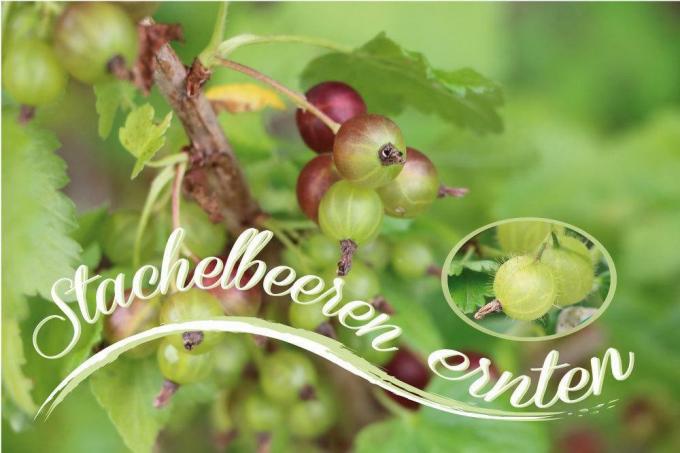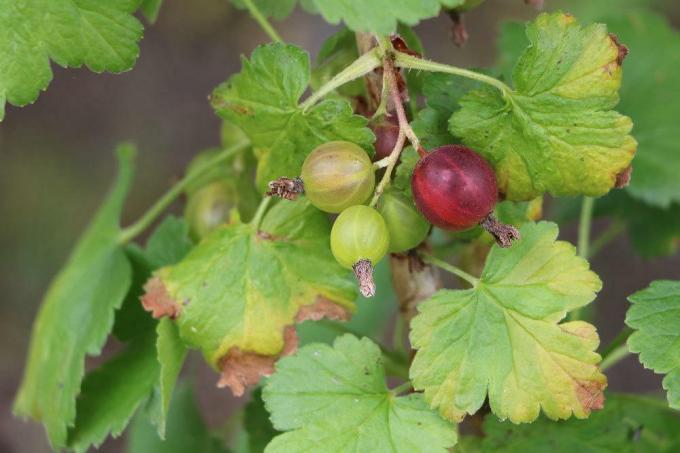
table of contents
- Harvest time
- harvest
- Unripe berries
- Green selection
- Ripe berries
Easy to care for, tolerates partial shade and the fruits are sweet and sour on the tongue. Gooseberries have been part of Central European cuisine for centuries and are eaten raw or processed as compote. Many people like to harvest the soft fruit, although not only the bushes in their own garden, but also wild forms in forests and bushes are not spared. The harvest time is crucial, as is when these are ripe and digestible for the stomach.
Harvest time
Do you know that? You can find gooseberries (bot. Ribes uva-crispa) during your walk in the forest and the berries look so good to eat. In no time they are picked and land in the mouth. The still slightly sour taste spreads and a few hours later you feel a little uncomfortable in the stomach. Then the gooseberries weren't quite ripe. When you harvest the berries does not only depend on the period of harvest. The ripening time also plays an important role here, as the berries are harvested depending on their intended use. However, the general harvest time takes place as follows.
- unripe berries: Beginning of May - June, depending on the weather
- ripe berries: June - end of August

Gooseberries can theoretically be harvested twice a year due to their different uses. However, it must be taken into account what they are used for and how the point in time affects the possible uses. The following locations have a strong effect on the formation of the fruit and in most cases less yield is to be expected.
- locations in full sun: too much sun without shade burns leaves, flowers and fruits
- Dryness: dry locations also ensure a lower crop yield, as this stresses the plants
It is therefore best to choose bushes for your harvest that have sufficient shade available, for example in forests or near fruit trees. And don't worry. Avoid the spikes with gardening gloves, long-sleeved clothes and a little patience.
Tip: Note that the development of the unripe fruits may be delayed in May if late frosts have occurred. Ribes uva-crispa is very robust and copes well with the temperatures in Germany, but it can Frost has a negative effect on flower formation, which inevitably leads to a later harvest with a lower yield can.

harvest
When to harvest berries
Gooseberries are one of those plants that can be used in several ways. The two maturity levels listed below come into question.
Unripe berries
Unripe gooseberries develop very early and can be picked from May without any problems in good weather. At this point they are still a bit smaller and very acidic. Even adults grimace when immature. In addition, the shell is still very thick at this stage and can burst a little in the stomach, as it is quite difficult to digest. You shouldn't eat the unripe fruits raw, but you can do a lot with them if you process them into the following items.
- compost
- jam
- juice
- Cake topping
Green selection
the Green selectionThis is the name given to harvesting the unripe gooseberries, and is primarily used for further storage of the berries. Since the fruits of Ribes grossularia, another name of the species, cannot be transported when ripe they are only harvested in large quantities in the immature state for further processing can. For this reason, you will usually only find green, extremely sour gooseberries in the supermarket, which you can then process. The advantage: the green selection contains a lot of pectin compared to the ripe fruits, which makes the use of an additional gelling agent for further processing unnecessary.

Ripe berries
Gooseberries begin to ripen in edible form in June, usually in mid-June and this process continues until the end of August. Every day the berries get bigger, change in color, for example to a bright red, and the aroma becomes sweeter and sweeter. Did you know that the ripe fruits of the Ribes uva-crispa have the second highest sugar content of the local berries after table grapes and grapes? However, this sweetness is only reached towards the end of the harvest season. However, they are ripe by mid-June. The possible uses from this stage onwards are as follows.
- Jelly: Mid-June to early July
- Jam: Mid-June to mid-July
- raw consumption: Mid-July to the end of the ripening period
Since it is almost no longer possible to transport the ripe berries from mid-July, they are harvested and nibbled directly from the bush from this point on. If you carry out the green selection and the harvest of the ripe fruits together during the year, you can enjoy them from May to the end of August. Different varieties do not affect the length of the harvest and ripening period.
Tip: You can tell whether your gooseberry bush has been well cared for by the abundance of berries. The more the branches bend down under the weight of the berries, the higher the yield and the better the plant is doing.
